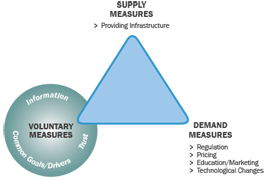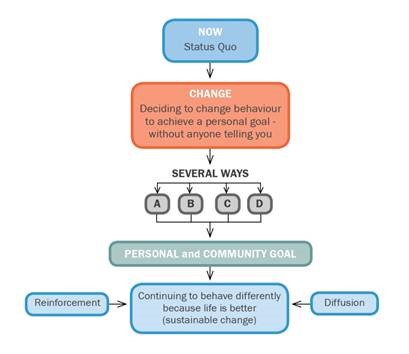Changing People’s Behaviour – How?
There are several complementary ways to change people’s behaviour – whether in response to climate change, or to improve environmental behaviours in general.

Supply Measures or Supply Management
These measures are those which provide infrastructure and services as a way of managing the system. They range from building a bike path to encourage cycling, to building a desalination plant to provide more water, to expanding sub-stations to reduce electricity brown-outs, to opening a transfer station to encourage recycling. In long term climate change adaptation programs supply measures could include constructing retaining walls or relocating buildings. In emergency management these are likely to be passive interventions – providing safer places in the neighbourhood or prescribed burning or installing sprinkler systems for bush-fire management.
Demand Measures
Another group of measures that bring about change have been termed demand measures; in other words, encouraging change by influencing what economists call ‘demand’. There are 4 main behaviour change measures in this category. They are:
Regulation: Regulation (e.g., water restrictions, reducing parking, establishing building codes or fines for not clearing properties) can cause significant changes in behaviour;
Pricing: Changing the price of an activity or a good can also change behaviour. Examples of price measures of would be higher petrol or energy prices, increased rates for households in flood prone areas or subsidies (e.g. low flow showerheads to reduce water use, compost bins or worm farms to reduce waste). While this is often the first mechanism considered by decision makers, it is not always found to be the most effective.
Education and awareness: Communications campaigns and education programmes (using many media types) are another way of ‘changing demand’ and have been successful in some cases. However there is a growing body of literature (e.g. Robinson) which suggests that communications rarely succeed on their own without demand, supply or voluntary behaviour change measures.
Technological measures: Changes in technology such automatic sorting of waste (allowing use of single bins) or using building materials to mitigate the impact of fire/flood/storm or communicating via SMS can also bring about changes.
Each of these supply and demand measures can be described as ‘top-down‘ or ‘controlled from the top’ . The advantages of approaches in this category are that they usually have a relatively immediate effect. The disadvantages are that they generally do not lead to long-term change, e.g. once the awareness campaign is over, or if the pricing change has ‘settled in’, behaviour can regress.
Voluntary Behaviour Change
The third of the triad of change measures – often overlooked, but often the cheapest and most effective is voluntary behaviour change. It involves encouraging people to change independently of the ‘top-down’ mechanisms of supply and demand management. It uses the approach of ‘helping people to help themselves’; working with people and encouraging their own ideas for change.
This approach is integral in all our thinking – although it is often used alongside other measures. It is based on the community development approach summarised well by Ellerman. Voluntary behaviour change can be defined as “change that occurs when individuals make choices for personal reward without a top-down mechanism, i.e., regulation of any sort, or feeling of external compulsion (Ampt 2003).
The Conditions Surrounding Voluntary Behaviour Change5
In the first instance, an individual or organisation decides to make a change so that he or she will improve their personal, business or community life in some way. The change may be triggered by any of the following:
- Arriving at a point where the negative effects of an existing activity reach a certain level of intolerance;
- Realising for the first time that it is possible to change;
- Hearing of someone else who has changed – particularly a “trusted other”;
- Experiencing a change moment, e.g., new job, house, partner (personal life), relocating, restructuring, new legislation (business);
- Feeling that change is the new way of doing things (new social norm).

This figure shows the processes that occur when individuals or communities make voluntary changes based on identifying a problem and taking personal responsibility.
Adding the voluntary behaviour change approach to the 2 commonly used approaches of changing behaviour (described here as supply and demand measures) has been shown to create long-lasting change. For example, a recent project in Western Australia to reduce households’ water consumption achieved a 21% reduction amongst those people involved in a voluntary behaviour change approach, compared to those who were not (the control group). It is also important to understand the 3 components that are needed in the community to support voluntary behaviour change:
Information: When people and groups are considering changes they want to make, they often need more information than they currently have. In a voluntary behaviour change programme information is only provided when people ask for it or when it has been discussed in a conversation or during coaching. People should not simply receive information packs – experience shows they are often ignored or discarded.
Trust: People need to feel that the initiative is part of a respected program and is being suggested by people they can trust. This will encourage the program’s longevity.
Common actions allowing different drivers: All participating stakeholders need to be striving for a common action – e.g. to be safer in times of emergency, to reduce food waste, or to increase physical activity. However, for each stakeholder there can be a different reason – for Councils and State Governments it might be to achieve climate change targets, for community organisations it might be to achieve social integration goals, for the community it might be to ‘keep my family safe’, to ‘save me time or money’, or to ‘get me to know more people in the community’.
